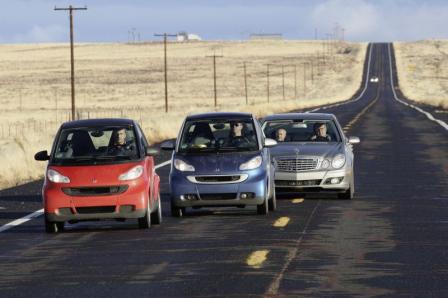Road Trip from Los Angeles to Detroit
Muamer Hodzic January 15, 2008
In an unusual long distance test the smart fortwo and the Mercedes-Benz E-Class demonstrated their top position among the most climate-friendly cars. On a trip from Los Angeles via Chicago to the Detroit Auto Show 2008 they demonstrated outstanding fuel-saving qualities in everyday real-world conditions. On the 4,400 kilometre route the smart fortwo mhd recorded an average consumption of just 4.8 litres per hundred kilometres (49 mpg). The two smart fortwo cdis were satisfied with 3.9 litres (60 mpg), and even the business saloon E 320 BLUETEC (US version) consumed an average of just 5.8 l/100 km (40.5 mpg).
The journey from smarthouse in Venice, a district of Los Angeles to Detroittook seven days. For a large part of the time the route led the test convoy consisting of one smart fortwo mhd, two smart fortwo cdis and an E 320 BLUETEC along the legendary old Route 66. Media representatives from Germany, Italyand the USAtook turns at the wheel. They had to cope with lonely highways, desert stretches, mountain passes and busy cities. And a severe spell of winter weather with fresh snow and temperatures of down to minus 15 degrees Celsius increased the challenge and made for tough driving conditions.
Despite these adverse conditions, the participants were impressed by the long-distance qualities of the smart fortwo models – cars that are actually designed for urban traffic. However, the high fuel-saving potential of all test vehicles was even more impressive:
– With its 52 kW/71 bhp 1 litre petrol engine the smart fortwo micro hybrid drive (mhd) showed that consumption of less than 5 litres per 100 kilometres can be achieved as a real on-the-road figure and carried its passengers 100 kilometres on 4.8 litres. This impressive figure is thanks to a new, sophisticated start-stop function that uses the idling phases to completely shut down the engine – for example at traffic lights, level crossings or in s top-and-go-traffic. As soon as the driver releases the brake pedal the engine starts automatically and the journey can continue immediately without a perceptible delay.
– On Route 66 the smart fortwo cdi proved that it rightly deserves the distinction of being the most economical production car with a combustion engine. Thanks to the world’s smallest direct injection diesel engine the 33 kW/45 bhp two-door model consumed just 3.9 litres per 100 kilometres in real-world conditions and travelled approximately 850 kilometres without refuelling.
– With the launch of the E 320 BLUETEC in 2006 Mercedes-Benz ushered in a new era of diesel engines in the USA. On the road trip to Detroitits 165 kW/224 bhp three litre V6 engine proved to be at least as economical as a four cylinder engine in everyday use. The average consumption was just 5.8 l/100 km. Moreover, thanks to the BLUETEC modular emission control system the popular business saloon is the world’s cleanest diesel and undercuts the strictest emission limit values worldwide. This is why the E 320 BLUETEC was named ” 2007 World Green Car” by journalists in the USA.
The E 320 BLUETEC has already won lots of fans in Americaand a European version, the E 300 BLUETEC is now available to customers in certain markets. The petrol version of the environmentally friendly smart fortwo will be available in the USAfrom this month.





Comments (5)
Pingback: Road Trip from Los Angeles to Detroit | Mercedes Info
Pingback: Road Trip from Los Angeles to Detroit
Pingback: As I was listening to the discussion about JCPenney’s Johnson and his mistakes, I noticed two talking heads discussing it. One said it perfectly: “Johnson’s mistake was not in going JCPenney to an everyday low-pricing technique, it was g